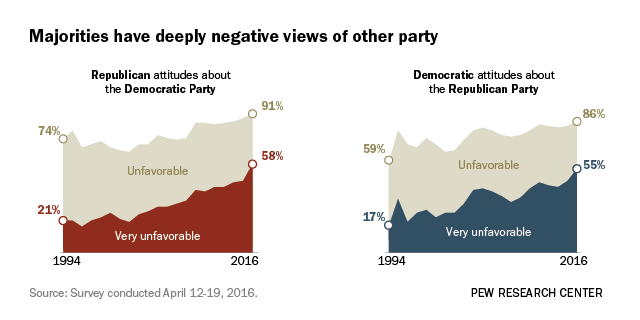
In this sense, American politics operated more like a four-party system, with jumbled liberal and conservative coalitions within and across the two parties. The Republican Party had a significant share of moderates and liberals, the inheritors of a tradition of moderate good-government Yankee republicanism that dated back to President Lincoln, and the Democratic Party once had a significant share of conservative populists from the South and the Great Plains. The ideologies of the party were less hard and fast 40 years ago. This brings us to the second trend that has contributed to the rise of negative partisanship: sorting. Practically speaking, elections are increasingly viewed as referendums on the president and the party that controls the White House, leaving little room for individual members of Congress to distinguish themselves from their national parties. National parties began building up major fundraising and campaign consultant-driven operations, helping to standardize their messaging so that it actually meant something to vote for a Democrat or a Republican.Ĭoupled with the steady decline of local media, this has resulted in a greater emphasis on national politics and less attention paid to local and state politics.

The civil rights movement of the 1960s and the culture wars of the 1970s and 1980s not only turned conservative Democrats into Republicans and liberal northeastern Republicans into Democrats, it also shifted the focus of politics such that Washington became the arbiter of national values. By the 1970s, in fact, many political observers declared that partisan politics had reached their end, with split-ticket voting hitting record-high levels as candidates successfully ran on local issues and pledges to better serve their constituents.īut beneath the surface, the parties were realigning. As President Eisenhower reportedly quipped as late as 1950, “There is not one Republican Party, there are 48 state Republican parties.” The same was true of the Democratic Party at the time. Sixty years ago, state and local politics loomed larger than they do now, which meant national parties operated more like loose labels whose main function was to come together every four years to argue over who should run for president under that party. The combination of these three trends has turned Washington, D.C., into a high-stakes battle where cross-party compromise is difficult, and both sides are increasingly holding out for complete control. The second is the sorting of Democrats and Republicans along urban/rural and culturally liberal/culturally conservative lines, and the third is the increasingly narrow margins in national elections. The first is the steady nationalization of American politics.

Broadly speaking, there are three trends that we can point to.


 0 kommentar(er)
0 kommentar(er)
